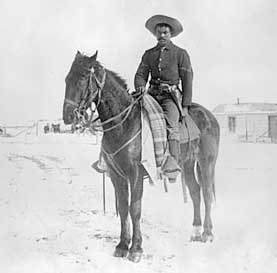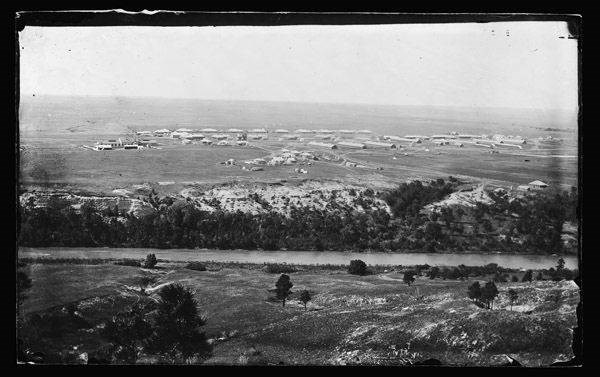Part of a series of articles titled Bugle Notes from the Fort.
Next: The Republican 4-20-1888
Article

University of Arizona/Denver Public Library
Who were the Buffalo Soldiers?
African Americans served in the U.S. Military during the Civil War and in many others throughout history like the Spanish-American War and the Philippine-American War. They were paid only $13 a month, a very small income, yet many African Americans enlisted because it was better pay than in civilian life.
In 1866, after the Civil War, Congress established six all-black regiments of soldiers fight in the "Indian Wars" as part of taking on the Western Frontier. Referring to black cavalry troops by the nickname "Buffalo Soldier" came from the Native Americans, who were reminded of the buffalo that roamed North America when they saw the soldiers' dark, curly hair and fierce nature of fighting.
Between 1891 and 1913 in California, Buffalo Soldiers served as some of the first care takers of the national parks.
In 1951, the last Buffalo Soldier regiments in service was disbanded, concluding over 85 years of distinguished service as part of the U.S. Army and great American History.
The National Parks Service has collected Buffalo Soldier History and stories for you to keep exploring online or in our parks.

NPS Photo
The Treaty of 1868 created the Great Sioux Reservation north of the Niobrara River in Dakota Territory. Over the next two decades, the U.S. Army proceeded to surround the reservation with a ring of forts to monitor the tribes.
Construction of Fort Niobrara, the southernmost of the forts, began in 1879 on a well-watered, well timbered site selected by General George Crook. This was close enough to monitor the Sioux, but far enough to avoid accidental friction between the tribes and the troops. The soldiers constructed a steam-powered sawmill to cut lumber and made adobe bricks. The fort was laid out in a standard military pattern with barracks and stables on one side of the parade ground and officers’ quarters on the other.
The soldier's daily routines were relatively peaceful; soldiers drilled, worked at construction and maintenance of the fort itself and shipped beef and supplies to the Rosebud Reservation. The fort served as an embarkation point for troops responding to the Pine Ridge outbreak, which culminated in the Wounded Knee massacre of 1890. Among the units stationed at Fort Niobrara were the African American troops of the 9th Cavalry.
The fort was closed in 1906, but served as a remount station until 1911. Today, all that remain of Fort Niobrara are a hay barn, some old foundations, the ringing memories of bugle calls, and the thunder of hooves that once rode through the prairie winds.
Part of a series of articles titled Bugle Notes from the Fort.
Next: The Republican 4-20-1888
Last updated: January 13, 2021